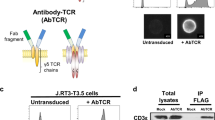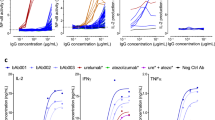Abstract
Due to their dual binding capacity, bispecific antibodies (bsAb) can be used to cross-link cytotoxic effector cells with malignant targets and may thereby improve adoptive immunotherapy. In this study, the development and preclinical testing of the quadroma-derived bsAb HD37xT5.16 of the specificity CD19xCD5 is reported. Effector cells used were a population of ex vivo expanded and activated T cells called cytokine-induced killer (CIK) cells expressing CD5. When combined with CIK cells, the cytolytic potency of HD37xT5.16 against CD19 positive B cell lymphoma lines was comparable to that observed with a previously described CD19xCD3 bsAb. Further on, we could demonstrate that bsAb CD19xCD5, in contrast to its CD3-binding counterpart, does not induce proliferation of resting T cells and causes only little activation-induced cell death. Therefore, this novel bsAb binding effector T cells via CD5 may be particularly useful in combination with adoptive transfer of ex vivo activated T cells, e.g., in the setting of adoptive immunotherapy after allogeneic stem cell transplantation. The in vitro studies outlined here support the experimental use of bsAb HD37xT5.16 in preclinical in vivo models for evaluation of its safety and efficacy profile.





Similar content being viewed by others
References
Alderson MR, Tough TW, Davis-Smith T, Braddy S, Falk B, Schooley KA, Goodwin RG, Smith CA, Ramsdell F, Lynch DH (1995) Fas ligand mediates activation-induced cell death in human T lymphocytes. J Exp Med 181:71–77
Baeuerle PA, Kufer P, Lutterbuse R (2003) Bispecific antibodies for polyclonal T-cell engagement. Curr Opin Mol Ther 5:413–419
Bohlen H, Hopff T, Manzke O, Engert A, Kube D, Wickramanayake PD, Diehl V, Tesch H (1993) Lysis of malignant B cells from patients with B-chronic lymphocytic leukemia by autologous T cells activated with CD3 x CD19 bispecific antibodies in combination with bivalent CD28 antibodies. Blood 82:1803–1812
Bohlen H, Manzke O, Patel B, Moldenhauer G, Dorken B, von Fliedner V, Diehl V, Tesch H (1993) Cytolysis of leukemic B-cells by T-cells activated via two bispecific antibodies. Cancer Res 53:4310–4314
Brunner T, Mogil RJ, LaFace D, Yoo NJ, Mahboubi A, Echeverri F, Martin SJ, Force WR, Lynch DH, Ware CF et al (1995) Cell–autonomous Fas (CD95)/Fas–ligand interaction mediates activation-induced apoptosis in T-cell hybridomas. Nature 373:441–444
Canevari S, Stoter G, Arienti F, Bolis G, Colnaghi MI, Di Re EM, Eggermont AM, Goey SH, Gratama JW, Lamers CH et al (1995) Regression of advanced ovarian carcinoma by intraperitoneal treatment with autologous T lymphocytes retargeted by a bispecific monoclonal antibody. J Natl Cancer Inst 87:1463–1469
Cochlovius B, Kipriyanov SM, Stassar MJ, Christ O, Schuhmacher J, Strauss G, Moldenhauer G, Little M (2000) Treatment of human B cell lymphoma xenografts with a CD3 x CD19 diabody and T cells. J Immunol 165:888–895
Csoka M, Strauss G, Debatin KM, Moldenhauer G (1996) Activation of T cell cytotoxicity against autologous common acute lymphoblastic leukemia (cALL) blasts by CD3xCD19 bispecific antibody. Leukemia 10:1765–1772
Daniel PT, Kroidl A, Cayeux S, Bargou R, Blankenstein T, Dorken B (1997) Costimulatory signals through B7.1/CD28 prevent T cell apoptosis during target cell lysis. J Immunol 159:3808–3815
de Gast GC, Haagen IA, van Houten AA, Klein SC, Duits AJ, de Weger RA, Vroom TM, Clark MR, Phillips J, van Dijk AJ et al. (1995) CD8 T cell activation after intravenous administration of CD3 x CD19 bispecific antibody in patients with non-Hodgkin lymphoma. Cancer Immunol Immunother 40:390–396
Dhein J, Walczak H, Baumler C, Debatin KM, Krammer PH (1995) Autocrine T-cell suicide mediated by APO-1/(Fas/CD95). Nature 373:438–441
Haagen IA, de Lau WB, Bast BJ, Geerars AJ, Clark MR, de Gast BC (1994) Unprimed CD4+ and CD8+ T cells can be rapidly activated by a CD3 x CD19 bispecific antibody to proliferate and become cytotoxic. Cancer Immunol Immunother 39:391–396
Hoyle C, Bangs CD, Chang P, Kamel O, Mehta B, Negrin RS (1998) Expansion of Philadelphia chromosome-negative CD3(+)CD56(+) cytotoxic cells from chronic myeloid leukemia patients: in vitro and in vivo efficacy in severe combined immunodeficiency disease mice. Blood 92:3318–3327
Kipriyanov SM, Moldenhauer G, Strauss G, Little M (1998) Bispecific CD3 x CD19 diabody for T cell-mediated lysis of malignant human B cells. Int J Cancer 77:763–772
Kornacker M, Moldenhauer G, Herbst M, Weilguni E, Tita-Nwa F, Harter C, Hensel M, Ho AD (2006) Cytokine-induced killer cells against autologous CLL: direct cytotoxic effects and induction of immune accessory molecules by interferon-gamma. Int J Cancer 119:1377–1382
Kroesen BJ, Bakker A, van Lier RA, The HT, de Leij L (1995) Bispecific antibody-mediated target cell-specific costimulation of resting T cells via CD5 and CD28. Cancer Res 55:4409–4415
Leemhuis T, Wells S, Scheffold C, Edinger M, Negrin RS (2005) A phase I trial of autologous cytokine-induced killer cells for the treatment of relapsed Hodgkin disease and non-Hodgkin lymphoma. Biol Blood Marrow Transplant 11:181–187
Lu PH, Negrin RS (1994) A novel population of expanded human CD3+CD56+ cells derived from T cells with potent in vivo antitumor activity in mice with severe combined immunodeficiency. J Immunol 153:1687–1696
Manzke O, Titzer S, Tesch H, Diehl V, Bohlen H (1997) CD3 x CD19 bispecific antibodies and CD28 costimulation for locoregional treatment of low-malignancy non-Hodgkin’s lymphoma. Cancer Immunol Immunother 45:198–202
Marme A, Strauss G, Bastert G, Grischke EM, Moldenhauer G (2002) Intraperitoneal bispecific antibody (HEA125xOKT3) therapy inhibits malignant ascites production in advanced ovarian carcinoma. Int J Cancer 101:183–189
Mehta BA, Schmidt-Wolf IG, Weissman IL, Negrin RS (1995) Two pathways of exocytosis of cytoplasmic granule contents and target cell killing by cytokine-induced CD3+ CD56+ killer cells. Blood 86:3493–3499
Pezzutto A, Dorken B, Rabinovitch PS, Ledbetter JA, Moldenhauer G, Clark EA (1987) CD19 monoclonal antibody HD37 inhibits anti-immunoglobulin-induced B cell activation and proliferation. J Immunol 138:2793–2799
Ruf P, Lindhofer H (2001) Induction of a long-lasting antitumor immunity by a trifunctional bispecific antibody. Blood 98:2526–2534
Scheffold C, Kornacker M, Scheffold YC, Contag CH, Negrin RS (2002) Visualization of effective tumor targeting by CD8+ natural killer T cells redirected with bispecific antibody F(ab’)(2)HER2xCD3. Cancer Res 62:5785–5791
Schlereth B, Quadt C, Dreier T, Kufer P, Lorenczewski G, Prang N, Brandl C, Lippold S, Cobb K, Brasky K, Leo E, Bargou R, Murthy K, Baeuerle PA (2006) T-cell activation and B-cell depletion in chimpanzees treated with a bispecific anti-CD19/anti-CD3 single-chain antibody construct. Cancer Immunol Immunother 55:503–514
Schmidt-Wolf GD, Negrin RS, Schmidt-Wolf IG (1997) Activated T cells and cytokine-induced CD3+CD56+ killer cells. Ann Hematol 74:51–56
Schmidt-Wolf IG, Lefterova P, Johnston V, Huhn D, Blume KG, Negrin RS (1994) Propagation of large numbers of T cells with natural killer cell markers. Bri J Haematol 87:453–458
Schmidt-Wolf IG, Lefterova P, Mehta BA, Fernandez LP, Huhn D, Blume KG, Weissman IL, Negrin RS (1993) Phenotypic characterization and identification of effector cells involved in tumor cell recognition of cytokine-induced killer cells. Exp Hematol 21:1673–1679
Schmidt-Wolf IG, Negrin RS, Kiem HP, Blume KG, Weissman IL (1991) Use of a SCID mouse/human lymphoma model to evaluate cytokine-induced killer cells with potent antitumor cell activity. J Exp Med 174:139–149
Segal DM, Weiner GJ, Weiner LM (1999) Bispecific antibodies in cancer therapy. Curr Opin Immunol 11:558–562
Strasser A (1995) Apoptosis: death of a T cell. Nature 373:385–386
van Spriel AB, van Ojik HH, van De Winkel JG (2000) Immunotherapeutic perspective for bispecific antibodies. Immunol Today 21:391–397
Verneris MR, Ito M, Baker J, Arshi A, Negrin RS, Shizuru JA (2001) Engineering hematopoietic grafts: purified allogeneic hematopoietic stem cells plus expanded CD8+ NK-T cells in the treatment of lymphoma. Biol Blood Marrow Transplant 7:532–542
Verneris MR, Karami M, Baker J, Jayaswal A, Negrin RS (2004) Role of NKG2D signaling in the cytotoxicity of activated and expanded CD8+ T cells. Blood 103:3065–3072
Verneris MR, Kornacker M, Mailander V, Negrin RS (2000) Resistance of ex vivo expanded CD3+CD56+ T cells to Fas-mediated apoptosis. Cancer Immunol Immunother 49:335–345
Zeidler R, Mysliwietz J, Csanady M, Walz A, Ziegler I, Schmitt B, Wollenberg B, Lindhofer H (2000) The Fc-region of a new class of intact bispecific antibody mediates activation of accessory cells and NK cells and induces direct phagocytosis of tumour cells. Br J Cancer 83:261–266
Acknowledgments
We thank Dr. Fabrice Le Gall (Affimed Therapeutics, Heidelberg) for the advice and help with the FPLC separation and Elvira Hallauer for expert technical assistance. This work was supported by the Deutsche Krebshilfe and the Tumorzentrum Heidelberg/Mannheim.
Author information
Authors and Affiliations
Corresponding author
Additional information
Freddy Tita-Nwa and Gerhard Moldenhauer contributed equally to the study and share first authorship.
Rights and permissions
About this article
Cite this article
Tita-Nwa, F., Moldenhauer, G., Herbst, M. et al. Cytokine-induced killer cells targeted by the novel bispecific antibody CD19xCD5 (HD37xT5.16) efficiently lyse B-lymphoma cells. Cancer Immunol Immunother 56, 1911–1920 (2007). https://doi.org/10.1007/s00262-007-0333-0
Received:
Accepted:
Published:
Issue Date:
DOI: https://doi.org/10.1007/s00262-007-0333-0




